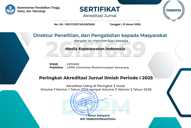Electronic Games to Reduce Child Pain Levels With Injection of Circumcision Anesthesia
(1) Akademi Keperawatan RS Dustira Cimahi
(2) Akademi Keperawatan RS Dustira Cimahi
(*) Corresponding Author
Abstract
Keywords
Full Text:
PDFReferences
Budi, M. (2012). Pengaruh penggunaan permainan elektronik terhadap nyeri saat prosedur perawatan luka pada pasien bedah ORIF di RSUD Purbalingga. Universitas Indonesia Library.
Dahlquist, L. M., Weiss, K. E., Law, E. F., Sil, S., Herbert, L. J., Horn, S. B., … Ackerman, C. S. (2009). Effects of videogame distraction and a virtual reality type head-mounted display helmet on cold pressor pain in young elementary school-aged children. Journal of Pediatric Psychology, 35(5), 574–584.
Inan, G., & Inal, S. (2018). The impact of 3 different distraction techniques on the pain and anxiety levels of children during venipuncture. The Clinical Journal of Pain, 35(2), 140–147.
Jameson,E., Trevena, J., Swain, N. (2011). P. R. M. 2011;16(1):. (2011). Electronic gaming as pain distraction. Electronic Gaming as Pain Distraction., I, 27–32.
Karita, D., & Romdhoni, M. F. (2018). Hubungan Usia dan Berat Badan Dengan Ukuran Lingkar Penis Anak Menggunakan O-Meter: Sirkumsisi Metode Klem. Herb-Medicine Journal, 1(1).
Kaur, B., Sarin, J., & Kumar, Y. (2014). Effectiveness of cartoon distraction on pain perception and distress in children during intravenous injection. IOSR Journal of Nursing and Health Science, 3(3), 8–15.
Kirkpatrick, T., & Tobias, K. (2013). PEDIATRIC AGE SPECIFIC Self Learning Module For Clinical Staff. Retrieved from UCLA Health System website: https://www.uclahealth.org/hr/workfiles/AgeSpecificSLM-Peds.pdf
Kyle, T., & Carman, S. (2014). Buku ajar keperawatan pediatri. Jakarta: EGC.
Lemos, I. C. S., Silva, L. G. da, Delmondes, G. de A., Brasil, A. X., Santos, P. L. F., Gomes, E., & Kerntop, M. R. (2016). Therapeutic play use in children under the venipucture: a strategy for pain reduction. American Journal of Nursing Research, 4(1), 1–5.
Marilyn-Eaton, H., Donna, W. L., Marilyn, W. L., David, W., & Patricia, S. (2008). Buku Ajar Keperawatan Pediatrik. Jakarta: EGC.
Prasetyo, B. (2018). Asupan Seng dan Penyembuhan Luka Sirkumsisi. JNH (Journal of Nutrition and Health), 6(2), 93–98.
Prasetyo, S. N. (2010). Konsep dan proses keperawatan nyeri. Yogyakarta: Graha Ilmu.
Sarfika, R., Yanti, N., & Winda, R. (2016). Pengaruh Teknik Distraksi Menonton Kartun Animasi Terhadap Skala Nyeri Anak Usia Prasekolah Saat Pemasangan Infus Di Instalasi Rawat Inap Anak RSUP DR. M. Djamil Padang. Jurnal Keperawatan Ners, 11(1), 32.
Sembiring, S. U., & Nauli, F. A. (2015). Perbandingan respon nyeri anak usia toddler dan prasekolah yang dilakukan prosedur invasif. Riau University.
Setyaningsih, T. S. A., & Wahyuni, H. (2018). Stimulasi Permainan Puzzle Berpengaruh terhadap Perkembangan Sosial dan Kemandirian Anak Usia Prasekolah. Jurnal Keperawatan Silampari, 1(2), 62–77.
Srouji, R., Ratnapalan, S., & Schneeweiss, S. (2010). Pain in children: assessment and nonpharmacological management. International Journal of Pediatrics, 2010.
Sulistiyo, A., Marini, G., & Agung, S. (2016). Efektifitas pemberian kompres hangat sebelum tindakan infasif pemasangan infus dalam mengurangi rasa nyeri anak usia 6-12 th di IGD RS Husada Utama (UMSurabaya Repository). Retrieved from http://repository.um-surabaya.ac.id/1608/
Wahyuni, H., Setyawati, S., & Inayah, I. (2015). Terapi Slow Deep Breathing Dengan Bermain Meniup Baling-Baling Terhadap Intensitas Nyeri Pada Anak Yang Dilakukan Penyuntikan Anestesi Sirkumsisi. Jurnal Skolastik Keperawatan, 1(2), 36–43.
Walco, G. A., Goldschneider, K. R., & Berde, C. B. (2008). Pain in children: a practical guide for primary care. https://doi.org/https://doi.org/10.1007/978-1-59745-476-6
Winahyu, D., Alfiyanti, D., & Solekhan, A. (2013). Pengaruh terapi bercerita terhadap skala nyeri anak usia prasekolah (3-6 tahun) selama tindakan pengambilan Darah Vena di RSUD Tugurejo Semarang. Karya Ilmiah, 2. Retrieved from http://182.253.197.100/e-journal/index.php/ilmukeperawatan/article/view/165
Article Metrics
Abstract view : 759 timesPDF - 42 times
DOI: https://doi.org/10.26714/mki.3.2.2020.75-80
Refbacks
- There are currently no refbacks.
Copyright (c) 2020 Tunggul Sri Agus Setyaningsih

This work is licensed under a Creative Commons Attribution 4.0 International License.
This journal is indexed by:
Kedungmundu Raya No. 18 Semarang NRC Building Universitas Muhammadiyah Semarang
Phone: 02476740287
Fax: 02476740287
Email: mki@unimus.ac.id





















